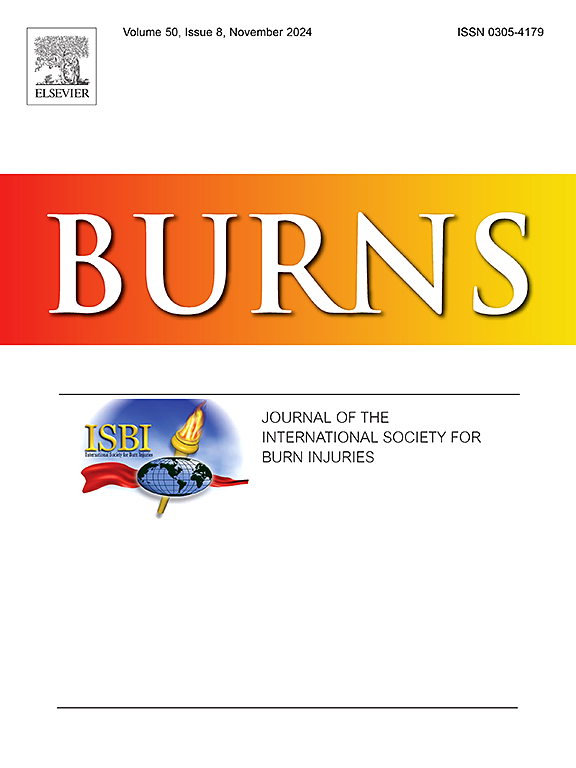The association between neighborhood disadvantage and patient-reported outcomes in burn survivors
IF 3.2
3区 医学
Q2 CRITICAL CARE MEDICINE
引用次数: 0
Abstract
Background
Burns can cause long-term complications including pain and poor physical function. While neighborhood disadvantage is associated with burn severity, its effect on long-term complications has not been investigated. We hypothesized that patients from areas of higher area of deprivation index (ADI) will report poorer long-term outcomes.
Methods
We linked patient data from the Burn Model System with ADI state decile (1 = least, 10 = most disadvantaged) using year and residence at time of injury. We performed bivariate analyses to identify associations between ADI and patient and burn characteristics and multivariate regressions to determine whether ADI was associated with PROMIS-29 pain and physical function 6- and 24-months post-burn.
Results
We included 780 patients; 69 % male, median age = 46 years, median ADI = 6, and median TBSA = 8 %. Multivariate regressions adjusting for TBSA, race, age, sex, anxiety, depression, and pain interference demonstrated that higher ADI was a significant predictor of higher pain intensity 6- (p = 0.001) and 24-months (p = 0.037) post-burn but not worse physical function 24-months post-burn (p = 0.089).
Conclusions
Higher neighborhood disadvantage was associated with higher long-term pain intensity post-burn. This study highlights the importance of socioeconomic factors that may impact long-term outcomes and the use of aggregate markers to identify patients at risk for worse outcomes.
烧伤幸存者的邻里劣势与患者报告结果之间的关系
烧伤可引起长期并发症,包括疼痛和身体功能低下。虽然邻里劣势与烧伤严重程度有关,但其对长期并发症的影响尚未得到研究。我们假设,来自贫困指数(ADI)较高地区的患者的长期预后较差。我们使用受伤时的年份和居住地将烧伤模型系统中的患者数据与 ADI 州十等分(1 = 最贫困,10 = 最贫困)联系起来。我们进行了双变量分析以确定 ADI 与患者和烧伤特征之间的关联,并进行了多变量回归以确定 ADI 是否与烧伤后 6 个月和 24 个月的 PROMIS-29 疼痛和身体功能相关。我们纳入了 780 名患者;其中 69% 为男性,年龄中位数= 46 岁,ADI 中位数= 6,TBSA 中位数= 8%。调整了 TBSA、种族、年龄、性别、焦虑、抑郁和疼痛干扰的多变量回归表明,较高的 ADI 是烧伤后 6 个月 (p = 0.001) 和 24 个月 (p = 0.037) 较高疼痛强度的重要预测因素,但并不影响烧伤后 24 个月较差的身体功能 (p = 0.089)。较高的邻里劣势与烧伤后较高的长期疼痛强度相关。这项研究强调了可能影响长期预后的社会经济因素的重要性,以及使用综合标记物来识别预后较差风险患者的重要性。
本文章由计算机程序翻译,如有差异,请以英文原文为准。
求助全文
约1分钟内获得全文
求助全文
来源期刊

Burns
医学-皮肤病学
CiteScore
4.50
自引率
18.50%
发文量
304
审稿时长
72 days
期刊介绍:
Burns aims to foster the exchange of information among all engaged in preventing and treating the effects of burns. The journal focuses on clinical, scientific and social aspects of these injuries and covers the prevention of the injury, the epidemiology of such injuries and all aspects of treatment including development of new techniques and technologies and verification of existing ones. Regular features include clinical and scientific papers, state of the art reviews and descriptions of burn-care in practice.
Topics covered by Burns include: the effects of smoke on man and animals, their tissues and cells; the responses to and treatment of patients and animals with chemical injuries to the skin; the biological and clinical effects of cold injuries; surgical techniques which are, or may be relevant to the treatment of burned patients during the acute or reconstructive phase following injury; well controlled laboratory studies of the effectiveness of anti-microbial agents on infection and new materials on scarring and healing; inflammatory responses to injury, effectiveness of related agents and other compounds used to modify the physiological and cellular responses to the injury; experimental studies of burns and the outcome of burn wound healing; regenerative medicine concerning the skin.
 求助内容:
求助内容: 应助结果提醒方式:
应助结果提醒方式:


